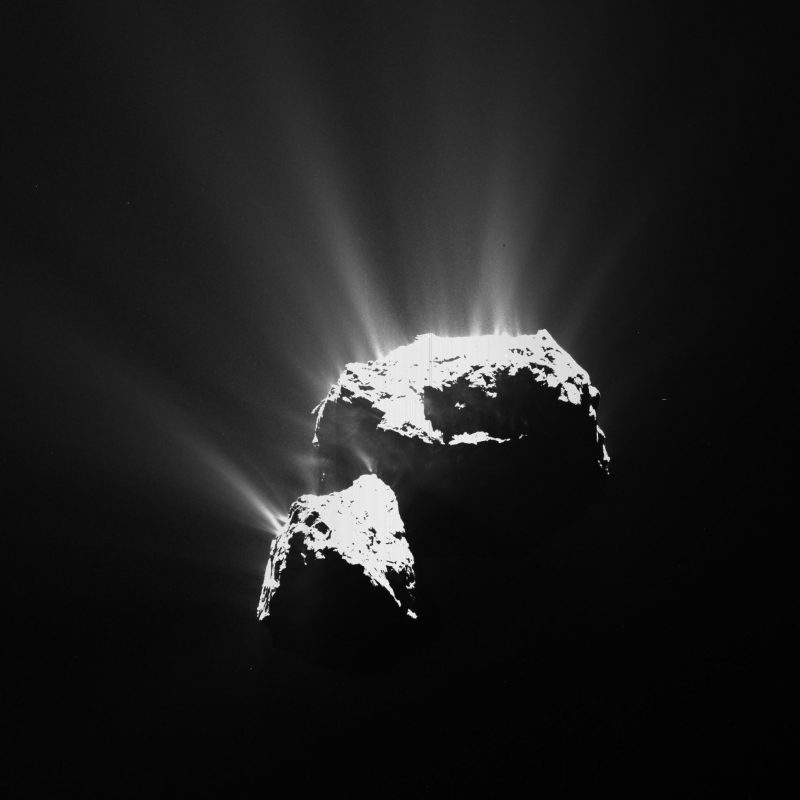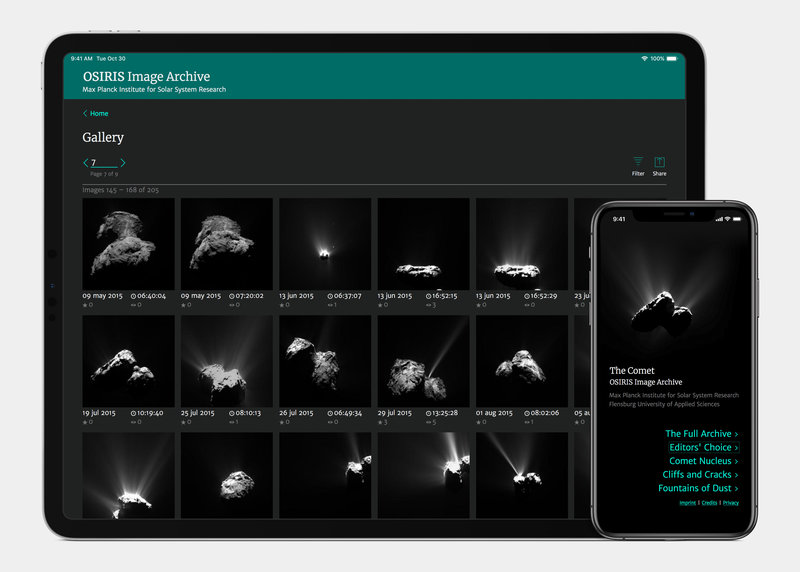
Prepare to browse! The Max Planck Institute for Solar System Research (MPS) announced April 17, 2019, that a new online viewing system – called the OSIRIS Image Viewer – has been created to provide members of the public with an easy way to view some 70,000 images of Rosetta’s comet. That is comet 67P/Churyumov-Gerasimenko, visited by the Rosetta spacecraft, which was built by the European Space Agency. Rosetta successfully rendezvoused with the comet in 2014. It traveled with the comet through the most active part of any comet’s orbit – its perihelion, or closest point to the sun – in mid-2015. Rosetta captured unprecedented images of the comet with its camera system OSIRIS. The images show rugged cliffs, bizarre cracks and gorges, powdery-smooth plains and boulder-covered fields, and who knew – before Rosetta – that comets had such things? It also captured spectacular images of jets of dust and gas in the vicinity of the comet’s nucleus. In September 2016, the spacecraft was intentionally crash-landed on the comet, capturing images until the final moments before it careened into the comet’s surface. MPS said the images:
… not only document the most extensive and demanding comet mission to date, but also show the duck-shaped [comet] body in all its facets … The OSIRIS Image Viewer is suited to the needs of both laymen and experts and offers quick and easy access to one of the greatest scientific treasures of recent years.
To that, I say amen! Just look, and you’ll see.
Browse images of comet 67P via the OSIRIS Image Viewer
The OSIRIS Image Viewer lives up to its claim of giving easy access. I found it very easy to understand and navigate. You can view the images of comet 67P in multiple ways, from a simple browse of all the images, to editor’s choice, to particular dates. Some dates to keep in mind? MPS pointed out:
The first view of comet 67P/Churyumov-Gerasimenko was captured by the OSIRIS camera system in March 2014 from a distance of almost five million kilometers: an unspectacular starry sky in which only experts can identify one of the numerous bright spots as the target of the Rosetta mission.
More important dates … The Rosetta spacecraft rendezvoused with 67P on August 6, 2014, and entered orbit on September 10, 2014. Rosetta’s lander, Philae, landed on the comet’s surface on November 12, 2014, becoming the first spacecraft to land on a comet nucleus and then immediately bounce out of view. There are images on the viewer that document:
… the feverish search for Philae’s landing site during the mission’s final weeks.
The main event was the comet’s close pass near the sun. Comet 67P reached perihelion on August 13, 2015, so the months around that date are when the comet was most active, producing, as these scientists said:
… fireworks of dust and gas emissions.
The Rosetta spacecraft ended its mission, crash-landing on the comet in its Ma’at region, on September 30, 2016. MPS explained:
The mission’s last snapshot was taken on September 30, 2016, just a few minutes before the spacecraft touched down on the comet. Only 20 meters separate the stony surface visible in it from the spacecraft.
Here’s what a page from the OSIRIS Image Viewer looks like:

Holger Sierks, OSIRIS Principal Investigator, commented:
It is important to us that this treasure trove of data is easily accessible to everyone. No prior knowledge is necessary.
To design the viewer, the MPS scientists worked in cooperation with students and lecturers from the Department of Information and Communication at the University of Applied Sciences Flensburg. The team said they designed the viewer:
… in such a way that all images and additional information can be found quickly. Each of the almost 70,000 images is supplemented with the date on which it was taken, the distance to the comet, and a short accompanying text and can be downloaded in full resolution. For users who wish to delve deeper or use the archive for scientific purposes, the images are also available in scientific data format; in addition, there is information available on the filters used, focal lengths, and exposure times as well as references to the scientific documentation and evaluation software.
Since June 2018, the ESA Archive Image Browser and ESA’s Planetary Science Archive have also been providing all images and data from the Rosetta mission online. Sierks said:
ESA’s databases are primarily aimed at scientists. We see the OSIRIS Image Viewer as a supplement to these services. It is designed to be easily accessible and appealing for everyone – and above all show the comet in all its beauty.
Bottom line: Check out the OSIRIS Image Viewer to see the images of comet 67P/Churyumov-Gerasimenko, visited by the Rosetta spacecraft from 2014 to 2016.











